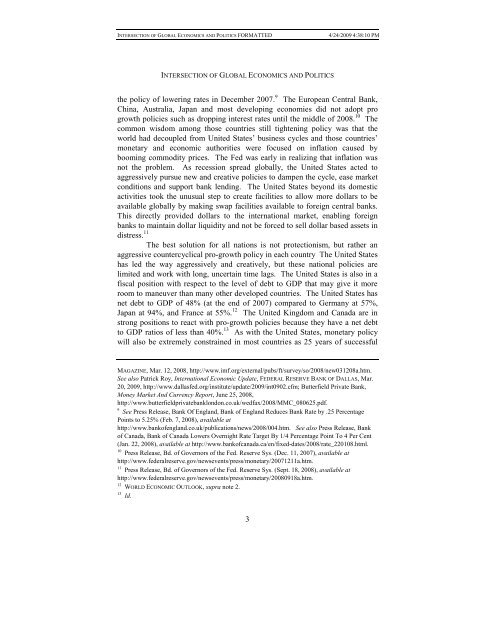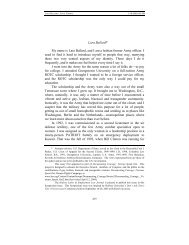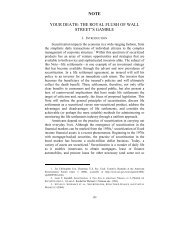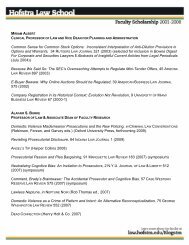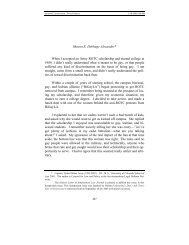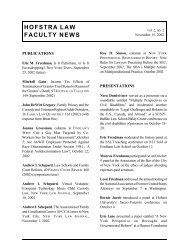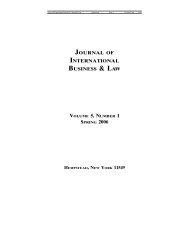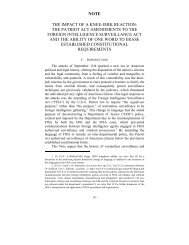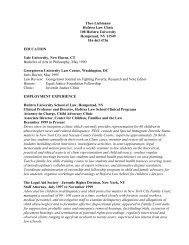JOURNAL OF INTERNATIONAL BUSINESS & LAW - Hofstra Law ...
JOURNAL OF INTERNATIONAL BUSINESS & LAW - Hofstra Law ...
JOURNAL OF INTERNATIONAL BUSINESS & LAW - Hofstra Law ...
Create successful ePaper yourself
Turn your PDF publications into a flip-book with our unique Google optimized e-Paper software.
INTERSECTION <strong>OF</strong> GLOBAL ECONOMICS AND POLITICS FORMATTED4/24/2009 4:38:10 PMINTERSECTION <strong>OF</strong> GLOBAL ECONOMICS AND POLITICSthe policy of lowering rates in December 2007. 9 The European Central Bank,China, Australia, Japan and most developing economies did not adopt progrowth policies such as dropping interest rates until the middle of 2008. 10 Thecommon wisdom among those countries still tightening policy was that theworld had decoupled from United States’ business cycles and those countries’monetary and economic authorities were focused on inflation caused bybooming commodity prices. The Fed was early in realizing that inflation wasnot the problem. As recession spread globally, the United States acted toaggressively pursue new and creative policies to dampen the cycle, ease marketconditions and support bank lending. The United States beyond its domesticactivities took the unusual step to create facilities to allow more dollars to beavailable globally by making swap facilities available to foreign central banks.This directly provided dollars to the international market, enabling foreignbanks to maintain dollar liquidity and not be forced to sell dollar based assets indistress. 11 The best solution for all nations is not protectionism, but rather anaggressive countercyclical pro-growth policy in each country The United Stateshas led the way aggressively and creatively, but these national policies arelimited and work with long, uncertain time lags. The United States is also in afiscal position with respect to the level of debt to GDP that may give it moreroom to maneuver than many other developed countries. The United States hasnet debt to GDP of 48% (at the end of 2007) compared to Germany at 57%,Japan at 94%, and France at 55%. 12 The United Kingdom and Canada are instrong positions to react with pro-growth policies because they have a net debtto GDP ratios of less than 40%. 13 As with the United States, monetary policywill also be extremely constrained in most countries as 25 years of successfulMAGAZINE, Mar. 12, 2008, http://www.imf.org/external/pubs/ft/survey/so/2008/new031208a.htm.See also Patrick Roy, International Economic Update, FEDERAL RESERVE BANK <strong>OF</strong> DALLAS, Mar.20, 2009, http://www.dallasfed.org/institute/update/2009/int0902.cfm; Butterfield Private Bank,Money Market And Currency Report, June 25, 2008,http://www.butterfieldprivatebanklondon.co.uk/wedfax/2008/MMC_080625.pdf.9 See Press Release, Bank Of England, Bank of England Reduces Bank Rate by .25 PercentagePoints to 5.25% (Feb. 7, 2008), available athttp://www.bankofengland.co.uk/publications/news/2008/004.htm. See also Press Release, Bankof Canada, Bank of Canada Lowers Overnight Rate Target By 1/4 Percentage Point To 4 Per Cent(Jan. 22, 2008), available at http://www.bankofcanada.ca/en/fixed-dates/2008/rate_220108.html.10 Press Release, Bd. of Governors of the Fed. Reserve Sys. (Dec. 11, 2007), available athttp://www.federalreserve.gov/newsevents/press/monetary/20071211a.htm.11 Press Release, Bd. of Governors of the Fed. Reserve Sys. (Sept. 18, 2008), available athttp://www.federalreserve.gov/newsevents/press/monetary/20080918a.htm.12 WORLD ECONOMIC OUTLOOK, supra note 2.13 Id.3


